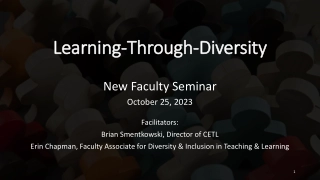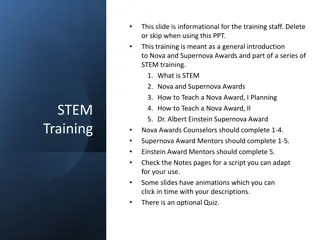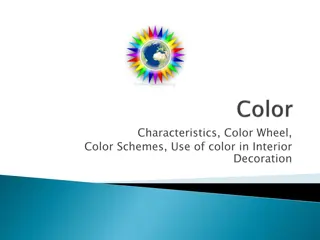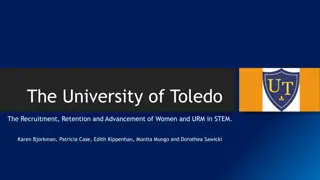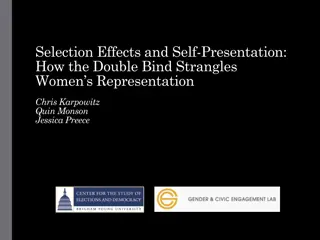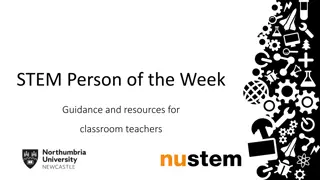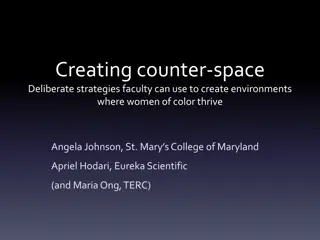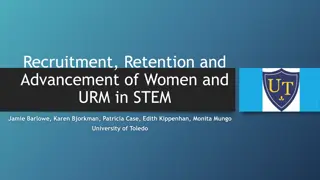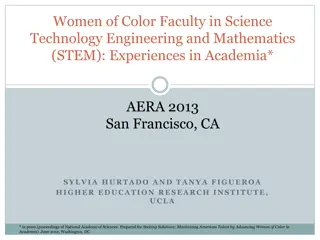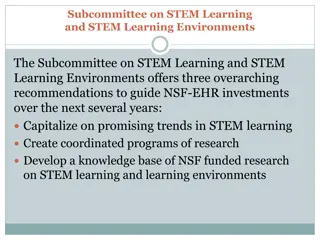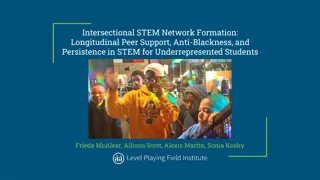Understanding the Double Bind: Challenges for Women of Color in STEM
The Double Bind concept explores the challenges faced by women of color in science, technology, engineering, and mathematics (STEM) fields. Highlighted in two key documents from 1976 and 2011, it reveals how women of color often experience exclusion and biases due to their race and gender. Recommendations include the need for tailored support programs and initiatives to address the unique obstacles faced by minority women in STEM. The persistence of the Double Bind underscores the ongoing need for diversity and equity in STEM fields.
Download Presentation

Please find below an Image/Link to download the presentation.
The content on the website is provided AS IS for your information and personal use only. It may not be sold, licensed, or shared on other websites without obtaining consent from the author. Download presentation by click this link. If you encounter any issues during the download, it is possible that the publisher has removed the file from their server.
E N D
Presentation Transcript
Setting the UC Context for Issues of the Double Bind Yolanda Moses Associate Vice Chancellor for Diversity, Excellence, and Equity & Professor of Anthropology UC Riverside ADVANCE PAID Program
Two Key Documents in the Double Bind Literature 1) (1976). Malcolm, Hall, and Brown. The Double Bind: The Price of Being a Minority Woman in Science. American Association for the Advancement of Science 2) (2011). Ong, Wright, Espinosa, and Orfield. Inside the Double Bind: A Synthesis of Empirical Research on Undergraduate and Graduate Women of Color in Science, Technology, Engineering, and Mathematics. Harvard Educational Review ADVANCE PAID Program
The Double Bind (1976) There is little information and no data on the status of women of color in science. Women of color in science were excluded from programs for underrepresented populations or programs for women because of biases related to both their race or ethnicity and gender, constituting a double bind. Programs for underrepresented populations were dominated by male scientists or majority women: minority women were, in fact, falling somewhere in between the funded efforts to improve science opportunities for minorities and efforts to advance women in science. ADVANCE PAID Program
The Double Bind (1976) Conference attendees recommended that the educational system offer only what the system already offers male students : access to financial aid information, supportive student services, faculty role models, research training, counseling, and job placement services. Conference attendees recommended that employers institute flexible work schedules, financial and policy support for child care, grant writing education, career workshops, communication networks, mentoring, appointment to advisory councils, data collection by race and by gender. ADVANCE PAID Program
Inside the Double Bind (2011) The Double Bind continues: URM women remain proportionally underrepresented [in STEM] relative to their representation in the U. S. Population. Inadequacy of programs: history has borne out the reality that programs intended to serve women disproportionately benefit White women, and programs intended to serve minorities mainly benefit minority males. The double bind remains as the way in which race/ethnicity and gender function simultaneously to produce distinct experiences for women of color in STEM. ADVANCE PAID Program
Inside the Double Bind (2011) The pernicious myth that women of color are under- represented in STEM fields because they are simply not interested in pursuing scientific careers continues to circulate. Authors review research on undergraduate and graduate students; little research on the double bind for faculty in STEM. Support from peers and faculty are inadequate: Young women of color in science have to carry out a tremendous amount of extra, and indeed, invisible work in order to gain acceptance from their male . . . peers and faculty. ADVANCE PAID Program
Inside the Double Bind (2011) Research shows several common characteristics across the undergraduate, graduate, and faculty experience: Difficulties of transition and points of loss between the academic stages Critical role that climate plays in women s retention in STEM, including issues of isolation, identity, invisibility, negotiating/navigation, microaggressions on a daily basis, sense of belonging, and tokenism . . . Creating more women of color STEM PhDs and getting them into faculty positions could help foster cultural changes that would improve overall faculty support for and increase the enrollment and retention of minority women. ADVANCE PAID Program
What Do We Need to Know About UC? Some of the infrastructure problems found in the educational system have been addressed, i.e. access to financial aid information, research training, and career counseling. Family friendly policies for faculty are in place. Each campus has in place a diversity/equity structure to support women of color. Data collection is underway to help us define successes, challenges, and next steps. ADVANCE PAID Program
From Students to Scholars: Female Headcount by Ethnicity High School Graduates and UC Enrollees 2009-10 Degrees Conferred 2010-11 100% 90% 25% 33% 80% 43% 70% 75% 60% 14% 43% 50% 40% 37% White/Other 45% 30% Asian 20% Hispanic 27% 14% 16% American Indian 10% 1% 7% 1% 3% 3% 1% 1% 7% African American 4% 0% California HS Graduates UC Bachelor's conferred UC Doctorate's conferred UC Enrollees White/Other 66,112 3,823 10,887 1,312 Asian 27,966 6,580 9,493 245 Hispanic 90,627 4,004 4,099 130 American Indian 1,706 129 144 9 African American 14,547 657 827 57 Sources: UC ADVANCE PAID Data Portfolio from the following tables: Pipeline Analysis of California Public High School Students to UC Enrollees, 2009-10 Number and Percent of Total UC Bachelor Degrees Conferred by Gender, Ethnicity, and Discipline - 2010-11 Number and Percent of Total UC Doctoral Degrees Conferred by Gender, Ethnicity, and Discipline - 2010-11
UC tenure-line and equivalent Faculty, UC SBS Faculty, and UC STEM Faculty: Female Headcount by Ethnicity, Fall 2011 100% 90% 80% 70% 71% 73% 74% 60% 50% 40% White/Other 30% Asian Hispanic 20% 12% 16% 22% American Indian 10% 7% 6% 2% 1% 5% 1% 1% 5% African American 4% 0% UC Faculty UC SBS Faculty UC STEM Faculty White/Other 2,043 414 397 Asian 444 72 124 Hispanic 177 40 26 American Indian 31 9 3 African American 106 27 5 Source: UC ADVANCE PAID Data Portfolio from the following tables: Ladder and Equivalent Rank Faculty with Tenure by Discipline by Gender by Ethnicity with percentages UC Systemwide Female STEM Faculty by Ethnicity by Year UC Systemwide Female SBS Faculty by Ethnicity by Year
Ethnicity of Applicants, Interviewees and Hires for UC Faculty and UC STEM Faculty Positions, 2011-12 All Disciplines STEM Disciplines Only 100% 90% 80% 70% 60% White/Oth 50% Hispanic 40% African-Amer. 30% Amer.-Indian 20% Asian 10% 0% STEM Applicants STEM Applicants Interviewees Hires STEM Hires Interviewees White/Oth 72.3% 72.0% 70.0% 66.4% 69.1% 66.0% Hispanic 4.9% 6.1% 7.8% 4.4% 5.4% 7.5% African-Amer. 2.1% 2.4% 3.8% 2.0% 2.4% 4.4% Amer.-Indian 0.3% 0.5% 0.7% 0.1% 0.5% 0.0% Asian 20.4% 18.9% 17.7% 27.0% 22.7% 22.0% Source: UC Systemwide Faculty Search Data Report for 2011-12



